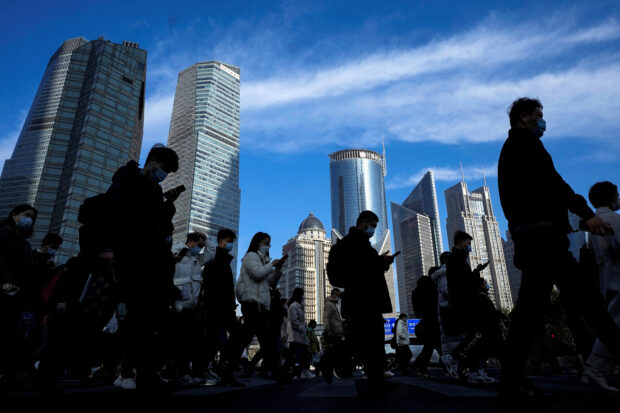
People cross a street near office towers in the Lujiazui financial district, ahead of the National People’s Congress (NPC), in Shanghai, China, Feb 28, 2023. REUTERS/Aly Song/File photo
BEIJING – China reported unexpectedly strong credit growth for February, with money supply expanding at the fastest pace in nearly seven years, as Beijing looks to support a nascent economic recovery amid rising global risks.
The government’s lifting of harsh pandemic curbs in December and other policy easing measures have started to rekindle credit demand in the world’s second-largest economy, after a COVID-induced slump in business and consumer confidence in the last few years.
Growth of outstanding total social financing (TSF), a broad measure of credit and liquidity in the economy, quickened to 9.9 percent in February from a year earlier, the highest since November 2022, and rising from 9.4 percent in January.
TSF includes off-balance sheet forms of financing that exist outside the conventional bank lending system, such as initial public offerings, loans from trust companies and bond sales.
Other key credit gauges also showed a solid pick-up.
Broad M2 money supply grew 12.9 percent from a year earlier, central bank data showed on Friday, the strongest pace since March 2016. The reading was well above estimates of 12.5 percent forecast in the Reuters poll and a 12.6- percent pace in January.
New bank lending fell much less than expected in February from a record high the previous month.
Chinese banks extended 1.81 trillion yuan ($260 billion) in new loans last month. Analysts polled by Reuters had predicted they would fall to 1.50 trillion yuan from 4.9 trillion yuan in January, and compared with 1.23 trillion yuan a year earlier.
“China’s strong credit extension in February has somehow offset the recent concerns clouding the pace of economic recovery, suggesting that the overall economy is still on a solid footing,” said Zhou Hao, economist at Guotai Junan International.A pull-back in February loans from January had been widely expected because Chinese banks tend to front-load loans at the beginning of the year to get higher-quality customers and win market share.
Also, the central bank had told some banks to slow the pace of lending to contain risks after January’s record credit spree, three bankers told Reuters last month. The banks were told to control the scale of new loans made in February.
Household loans, mostly mortgages, fell to 208.1 billion yuan in February from 257.2 billion yuan in January, while corporate loans fell to 1.61 trillion yuan from 4.68 trillion yuan.
China has set a modest target for economic growth this year of around 5 percent after it cooled to only 3 percent last year, the weakest in nearly half a century.
The economy has seen a tentative recovery since COVID measures were abruptly dismantled in December, but data so far this year has been somewhat mixed.
China’s factory sector grew in February at the fastest pace in more than a decade, the mobility of people and goods is clearly improving, and falling new home prices may have steadied. But consumer inflation unexpectedly slowed in February as consumers remain cautious, while China’s exports and imports fell again in the first two months of the year.
Among the other closely watched credit measures, outstanding yuan loans grew 11.6 percent in February from a year earlier — the highest since December 2021 and compared with 11.3 percent growth in January. Analysts had expected 11.4 percent growth.
TSF for the month of February fell to 3.16 trillion yuan from 5.98 trillion yuan in January, but was still well ahead of expectations for 2.20 trillion yuan.
READ:
China holds lending benchmarks for 6th month, but more easing seen

